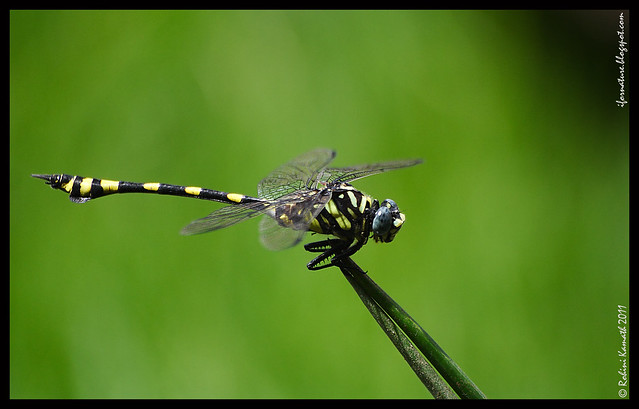
Common Clubtail (Ictinogomphus rapax)
This is a critter post. Though, I must say that was not the intent with which we went to Hoskote. A few weeks ago, K went with a friend for a drive to Hoskote where he found this pond with a lot of lilies in bloom.
Last week, he decided to take the long suffering spouse along instead; promising visions of natural beauty. To give him full credit, the day was splendid, road was very good. The spot was picturesque - a charming little lily pond (pink and white) with large neem trees which provided ample shade. It also had lots of dragonflies and damselflies. I have always liked them since they sit still and are fairly easy to spot owing to the colors they sport.

The lovely lake habitat @ Hoskote by Keshav
There were a few suspicious villagers at first but they soon tired of us when they saw we could spend hours fixed to a spot, trying to get a dragonfly in focus. The wonderful constant breeze ensured that we stayed cool even at noon; it also meant that dragonflies perched precariously on a blade of grass swayed about endlessly making me slightly dizzy.
The photographs taken here are shot handheld with my favorite Sigma 70-300mm, while crouched uncomfortably at the very edge of the little pond. Enough of background, onward towards odonates! (what is that you ask? )
Dragonflies are insects which belong to the order Odonata and infraorder Anisoptera
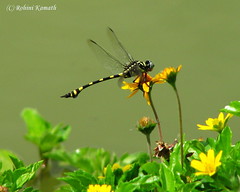
Archive Picture, taken at Bagmane TechPark
The Common Clubtail (Ictinogomphus rapax)
It is one of 27 Indian Peninsular Clubtail dragonflies ( easy to identify due to the bulge at the end of its tail. ) The bright yellow markings and its large size makes it easy to spot. ClubTails inhabit diverse aquatic habitats and many of them breed in streams and rivers. This one, I found perched on a reed like plant at the edge of this pond.
The male and female of the Common Clubtail are nearly identical in markings, the female having a bigger wingspan and a stouter body than the male. I couldn't find another for comparison, so I can't id the sex of this one. If you can, please let me know.
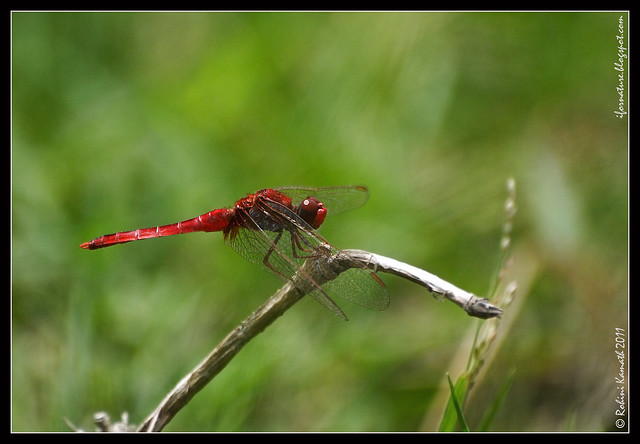
Ruddy Marsh Skimmer - Male
Ruddy Marsh Skimmer (Crocothemis servilia)
Its hard to miss this blood red guy ( only the male is red ) darting about. Its fairly common and I've seen them in many places near lakes, paddy fields and rivulets. The female is oddly enough - yellow in color with a black line running down the tail.
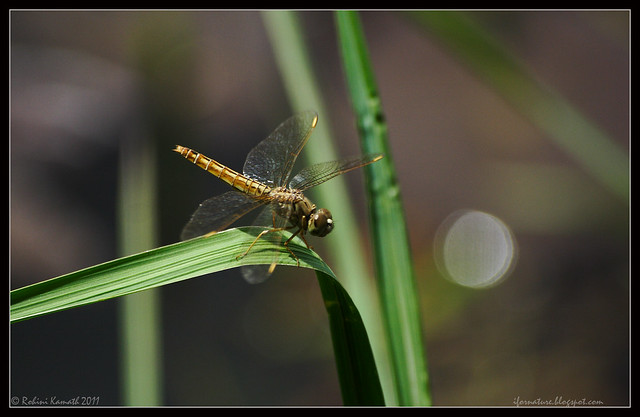
Ditch Jewel Female
Ditch Jewel (Brachythemis contaminata)
I spent a lot of time identifying this one - so if you think I'm wrong, please let me know. I was torn between ruddy marsh skimmer female and ditch jewel female.
This little dragonfly wasn't particularly attractive on the setting above, but just compare it with this archive image below as a companion to some nice yellow flowers!

Archive picture, taken at Bagmane Tech Park
The male, which I couldn't spot anywhere nearby; is supposedly orange with orange shaded wings. The female as seen here has transparent wings, with the yellow wingspot.

Blue Marsh Hawk - Male
Blue Marsh Hawk (Orthetrum glaucaum)
Fortunately, identifying male dragonflies is a lot easier than the female. I find that most of the females seem to look rather similar - light yellow/ brown in shade.
This particular dragonfly is also very common, I see it in my office on ORR. Although, it looks prettier and more exotic when seen among ponds and reeds. :-)
The female Blue Marsh is yellow ( who came up with these names? ) oddly enough and has black legs (our ditch jewel has brownish yellow legs so you cant confuse them )
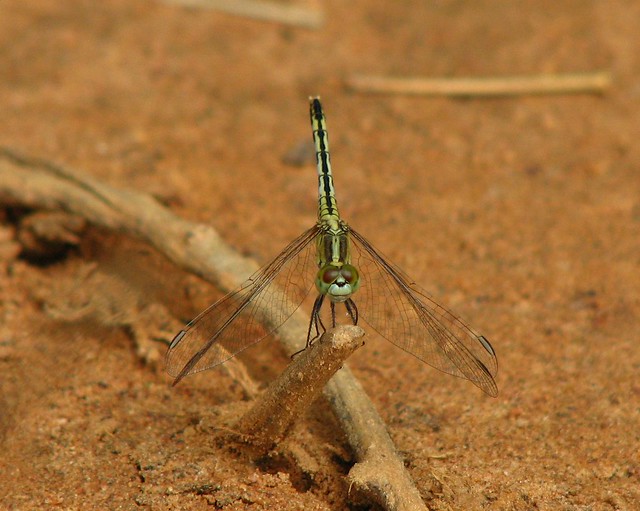
Ground Skimmer - Female at JP Nagar (archives)
Ground Skimmer(Diplocodes trivialis)
The ground skimmer male has a blue head and tail to help tell it apart from other skimmers. The female however is yellowish (again!) - green in colour. How am I sure this is a ground skimmer female? I'm not. So if you think differently, put a comment now or for ever hold your peace!
The female closely resembles sub-adult males (sigh, why is this so hard?), yet the book tells me that the anal appendages are yellow in the female and the tip of the tail looks yellow to me, hence proved.
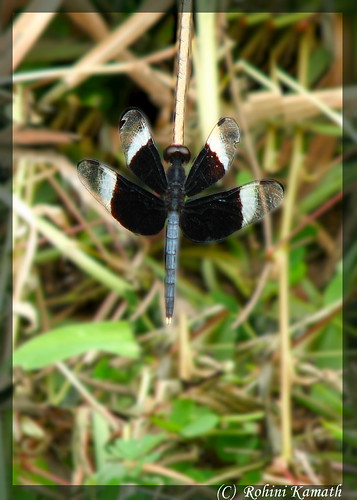
Archive Picture of Pied Paddy Skimmer Male, Katapadi Village near Udupi
Pied Paddy Skimmer (Neurothemis tullia)
Easy to identify, "pied" refers to black and white in naming conventions. The black and white colored wings make this an easy one. Even the female is easier than most, with the black wing tips.

Granite Ghost (Bradinopyga geminata)
This is a really old archive pic, one of my very first pics infact, taken in KunjarGiri, near Katapadi. This is a hard to spot dragonfly given the colouring and is very common in urban areas as well.
Also fleetingly seen but no pictures was the very pretty Common Picture Wing (Rhyothemis variegata) - a brilliantly yellow and black winged creature. I hope to get it when we visit next.
Damselflies
These are of the sub-order Zygoptera in the order Odonata. They are tiny and really hard to spot among grass and vegetation. They are even harder to photograph.
I saw and photographed 2 kinds of damselflies at the pond at Hoskote. But, given the wind, my unsteady hands and the not so great photos it produced, I will not be sharing them here. But they were good enough for identification.
So I can tell with much certainty that I saw :
1. Coromandel Marsh Dart (Ceriagrion coromandelianum)
This is a very bright little thing with a yellow tail and bright grass green thorax and green eyes.
2. Senegal Golden Dartlet (Ischnura senegalensis)
The first and only good photo of a damsel fly I have happens to be of the senegal golden dartlet ( taken at home, early morning under controlled conditions ). It seems to be fairly common since I seem to be finding them everywhere. Easily spotted by the bright blue spot at the end of the tail. Here seen sitting on a grass head.
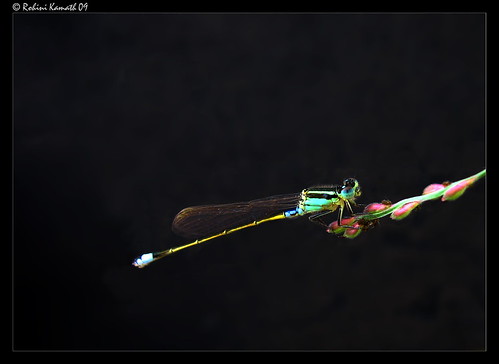
Senegal Golden Dartlet
A little data for those who are interested:
Taxonomy Kingdom:Animalia Phylum: Arthropoda Class: Insecta Order: Odonata | Categorization of Dragonflies 1. Clubtails 2. Mountain Hawks 3. Darners 4. Torrent Hawks 5. Skimmers |






5 comments:
you seem to excel in whatever you do :)
lovely descriptions and wonderful shots with your sigma i should say.
I suggest crop a more on the ground skimmer and it would pop up out of the screen!
happy blogging!
Lovely pics and narration ! Very informative too.
Learnt a lot about the dragonflies!
@Santosh: Thanks :) for your kind words as always.
Yes, I agree on the Ground skimmer - but it was an archive picture from when I was younger and dumber :D and now I'm older, wiser but lazier :D
Great shots!
Hey Rohini, awesome pictures, and a good read as well... I'm a dragonfly enthusiast from Bangalore as well, and am interested in learning to identify dragonflies and damselflies.
You can see some of my photographs at https://picasaweb.google.com/100347424576914126420/HereBeDragons, would really appreciate any help with identification.
Post a Comment
Please do not post ADs here, they will not be published. All comments are moderated.